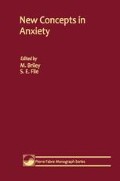Abstract
As anyone who has struggled in vain with the clues of a cryptic crossword will appreciate, the ease and speed with which we can solve anagrams depends largely on practice. However, other factors are important. It is generally easier to solve anagrams of shorter words than longer ones (Kaplan and Carvellas, 1968). Solution times are also faster for words with a higher frequency of usage (Mayzner and Tresselt, 1958). Perhaps more interestingly, Hunter (1956) showed that if subjects are instructed that all of the anagram solutions are taken from a particular semantic category (e.g. animals) then the mean solution time is faster than for naive controls. Boddy (1968) demonstrated that a task-induced set proves just as effective at increasing solution speed as the instructional set used by Hunter. He presented subjects with groups of anagrams, the solutions of which were drawn from the same category. After sucessfully solving two or three anagrams, the subjects formed the appropriate mental set (e.g. all solutions are animal words) and solved the remaining anagrams more quickly.
Preview
Unable to display preview. Download preview PDF.
References
Boddy, J. (1968). Task-induced set and anagram solution. Psych. Reports, 23, 1162.
Bourne, L. E., Ekstrand, B. R. and Dominowski, R. L. (1971). The Psychology of Thinking. Prentice-Hall, Englewood Cliffs, NJ.
Dalgleish, T. and Watts, F. N. (1990). Biases of attention and memory in disorders of anxiety and depression. Clin. Psych. Reviews, in press.
Duncan, C. P. (1966). Problem solving with a verbal response hierarchy. Psychonomic Science, 4, 147–8.
Eysenck, M. W., MacLeod, C. and Mathews, A. (1987). Cognitive functioning and anxiety. Psychological Research, 49, 189–95.
Hunter, I. M. L. (1956). The influence of set on problem solving. Br. J. Psychol., 57, 63–4.
John, C. H. (1988). Emotionality ratings and free-association norms of 240 emotional and non-emotional words. Cognition and Emotion, 2, 49–70.
Kaplan, I. T. and Carvellas, T. (1968). Effect of word length on anagram solution time. J. Verb. Learn. Verb. Behav., 7, 201–6.
Mathews, A., Richards, A. and Eysenck, M. W. (1989). Interpretation of homophones related to threat in anxiety states. J. Abnormal Psych., 98, 31–4.
Mayzner, M. S. and Tresselt, M. E. (1958). Anagram solution times: a function of letter order and word frequency. J. Exp. Psych., 56, 376–9.
Author information
Authors and Affiliations
Editor information
Editors and Affiliations
Copyright information
© 1991 Macmillan Publishers Limited
About this chapter
Cite this chapter
Dalgleish, T. (1991). The Effects of Trait-anxiety on Anagram Solution Times. In: Briley, M., File, S.E. (eds) New Concepts in Anxiety. Palgrave, London. https://doi.org/10.1007/978-1-349-11847-2_34
Download citation
DOI: https://doi.org/10.1007/978-1-349-11847-2_34
Publisher Name: Palgrave, London
Print ISBN: 978-1-349-11849-6
Online ISBN: 978-1-349-11847-2
eBook Packages: EngineeringEngineering (R0)

